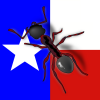This is a complex topic, and I think it would be best explained in this context by oversimplifying where possible, so I apologize if any part is unclear.
To state it as generally as possible--and this is perhaps more the case with arthropods than any other taxa--what we call a species can sometimes be a species complex, or a group of phenotypically [phenotype = physical characteristics of an organism] similar (or even identical) organisms which have unique genotypes [genotype = genetic makeup of an organism] that separate them into distinct lineages. So while two organisms may look similar or identical, they could come from these distinct lineages based on distribution or ecological circumstance.
I used to work with mosquitoes in the southeast, so an example I'm more intimately familiar with is the case of Anopheles quadrimaculatus, which is actually a complex of five identical but genetically distinct species. Whenever we collected members of this complex in the field, we would identify them as A. quadrimaculatus since we didn't need to distinguish it further.
Related to your question, Pogonomyrmex barbatus and P. rugosus are two closely related species; in fact, P. rugosus used to be described as a subspecies of P. barbatus (Pogonomyrmex barbatus rugosus)! They're often found in slightly different habitat, but in places where the two overlap, there has been hybridization between them. This hybridization has persisted for so long that is has created distinct genetic lineages, which form a complex. Members of some of these distinct lineages have unique mating requirements to produce workers, e.g., needing to mate with a male of the other species.
In your case, specifically, there isn't a way for you to look at your queen right now and know if you have one of the genetic lineages which require those specific circumstances. Your queen will produce workers, or she won't, and even then, you wouldn't know if you had one of these queens that didn't mate with the other species or just an infertile one from a different part of the complex which removed its wings.
I'm sorry there isn't a more satisfying answer than "you can't really know," but Pogonomyrmex swarms are pretty heavy, so it's likely that alates are getting what they need during the swarm; otherwise, these lineages wouldn't have persisted. My recommendation would be to just collect many queens when they fly, and you'll likely get more than enough for the colonies you want.
Edited by Cameron C. Thomas, June 24 2017 - 3:06 PM.















